While waiting at the Dubai International Airport after three whirlwind days at the opening of Sharjah Biennial 14 (hereafter SB14), I found myself idly looking back over my Instagram posts from the exhibition. Even though I had taken hundreds of photographs, videos and audio recordings of my experience at the exhibition, I had only shared 37 photographs and videos on Instagram.
In the past, I have appreciated how Instagram has emerged as a mechanism whereby you can encounter contemporary art exhibitions and biennials at a distance and from myriad perspectives, often in contrast with the official photography and videos produced by organizers and the press. For example, I recently wanted to watch Rupak a short film by Lala Rukh, which I encountered in the basement of the Athens Odeion at documenta 14 (hereafter d14) in 2017 (Rukh sadly passed away during the run of the exhibition). As there were no clips of the video online, I contacted Rukh’s estate (via Grey Noise gallery in Dubai) on the off-chance they would give me access to the film. (They could not, but they did generously send me a copy of the book they published about it and an extra copy for my university library). But what I was able to do was to reconstruct some of the 6 minute film from short (1 minute or less) clips posted on Instagram.
Back in the Dubai airport, while looking over my 37 posts, suddenly I received a steady stream of notifications that comments were being left on several of them. Each time it was from the same account and the same series of hashtags plus a fire-emoji:

Claire Tancons was the curator of Look For Me All Around You, one of the three exhibitions that made up SB14 and its overall title Leaving the Echo Chamber (along with Zoe Butt’s Journey Beyond the Arrow and Omar Kholeif’s Making New Time) and she was tagging all of my posts that included works from her part of the biennial. My immediate reaction was one of regret for not myself acknowledging the curator in my original posts and I started to add hashtags to the other posts with works selected by Butt and Kholeif respectively (for the remainder of the present post, I will use the shorthand of the curator’s name and the first word of their exhibition title after artists and works I reference). But as soon as I started, an idea occurred to me and I quickly erased these recent additions and proceeded to add to every one of my 37 Instagram posts the hashtag #echoisgolden. I had used this phrase as part of an intervention at d14 in the work Social Dissonance by Basque artist Mattin. I had annotated the ‘score’ to his durational concert (that took place for six days a week in both Athens and Kassel, overlapping when the exhibition took place in both locations) with a fragment of the ancient Greek lyric poet Simonides. In the fragment, Danae is whispering to Perseus, her infant son by Zeus (from the infamous ‘golden shower’), while cast out to sea on a wooden chest. Her imploring words to her child seemed to be directed at the god who had started all the trouble in the first place and in Echo is Golden I imagined her response as issuing from the mouths of the Greek performers’ of Mattin’s work (one of whom was called Danai!), speaking back to the artist in his absence, via a golden supplement to his score. Here it is (and thank you to VIER5 for the use of their font Pueblo, created for d14):
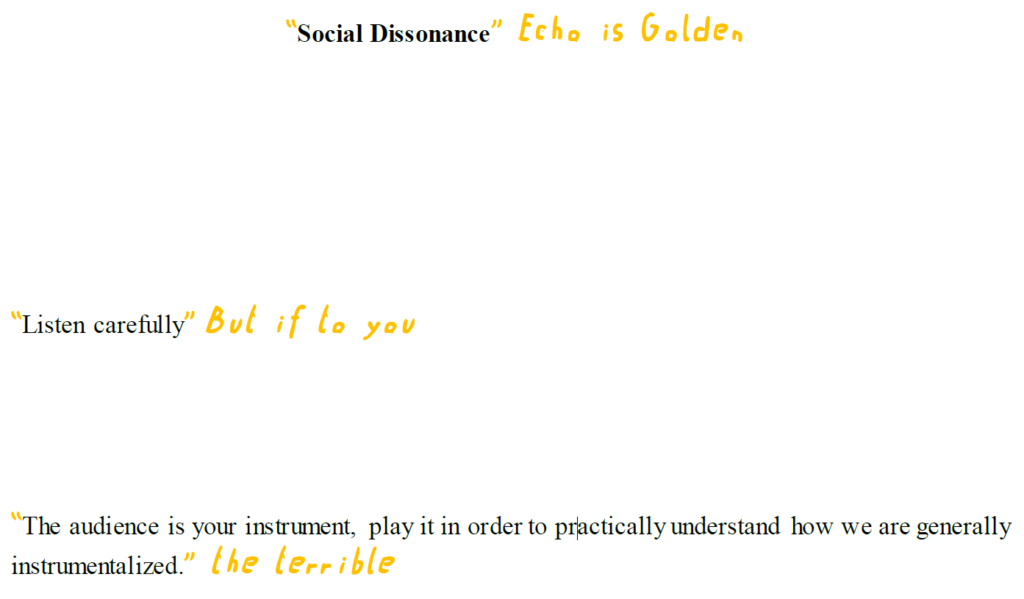
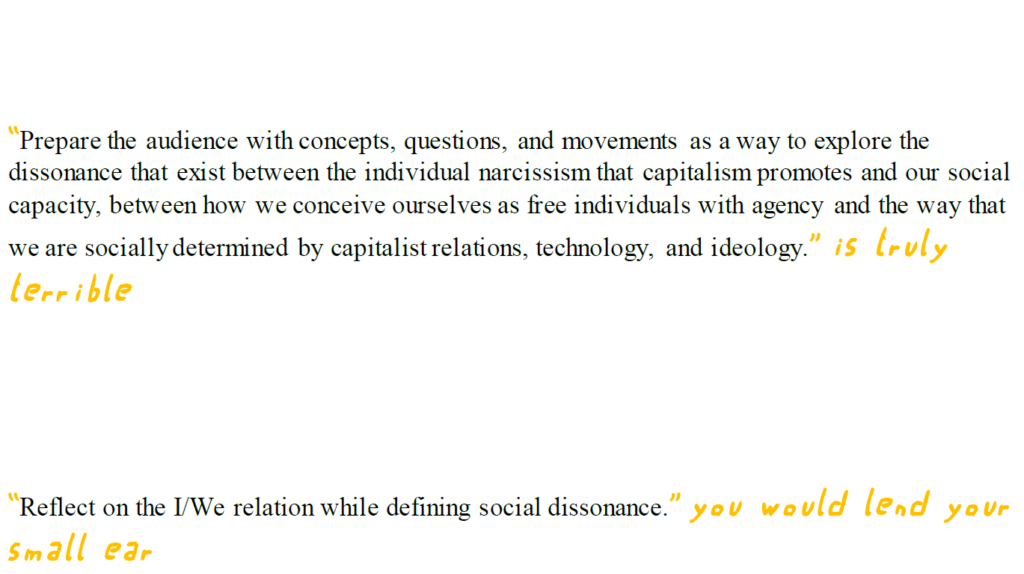
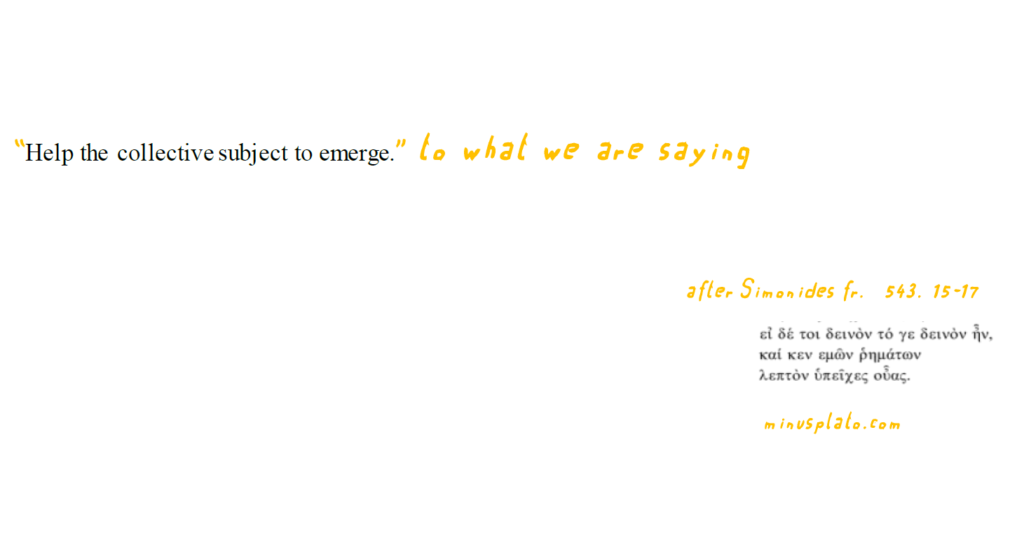
Now I am not completely sure why I responded to Tancons’ comments on my Instagram posts by adding the hashtag #echoisgolden from my d14 intervention. Sure, I was visiting SB14 as part of my research into the legacies of d14 at other global biennials, but other than that, it wasn’t clear to me how the phrase “Echo is Golden” was meant to explicitly make sense, either of the exhibition, or its connection with d14. What I do know is that it was at that moment of adding the hashtag that I would make this phrase the heading of a chapter or sub-chapter of the book I would write, provisionally titled The Great Unlearning: Artistic Precedence and Decolonizing Curriculum at and after documenta 14.
While this book is still very much ‘to come’, today as I slowly recover from jet lag, I want to use this extra-long and meandering post to expand on each of the 37 Instagram posts to see if, in doing so, I can clarify to myself what ‘Echo is Golden’ could mean for SB14 as some kind of response to or resonance with d14. This is not a review of the exhibition (I attended SB14 as a guest and not as a member of the press). Instead it is an intervention inspired by the following description of the concept precedence by Rolando Vazquez (as an alternative to the concept of ‘the contemporary’):
“[Precedence] is a way to relate deep temporalities, in which what precedes us is not immanent, not fully contained in the now of the present, but it is both ahead of us and before us.”
Journey to SB14 (March 5-7, 2019)
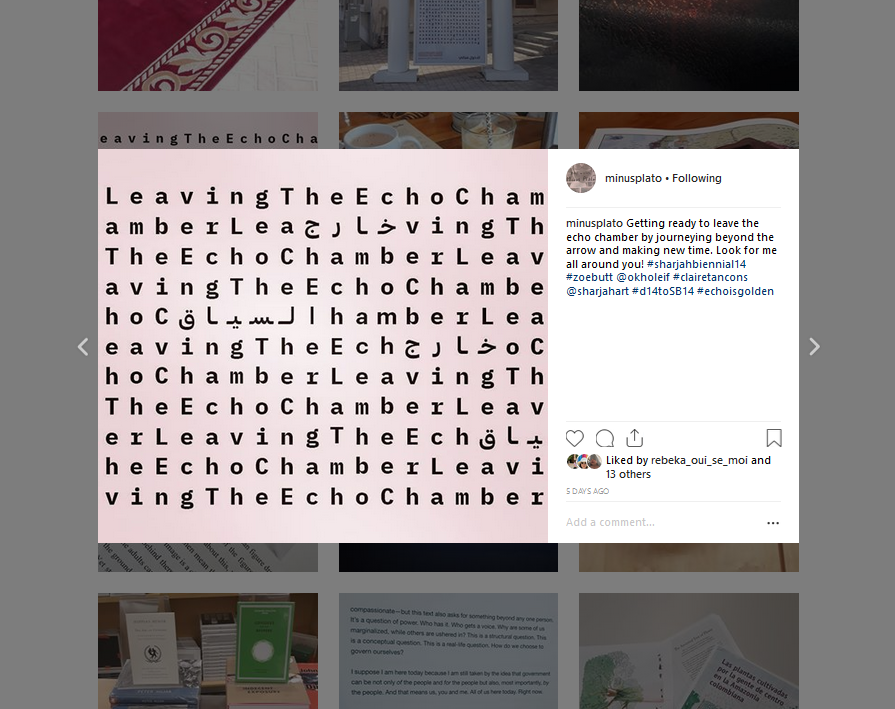
I wrote this first post at the Columbus, Ohio airport at the very start of my long journey to Sharjah and I fused together the overall title of the biennial and those of the three individual exhibitions, as if to describe my own actions and those of my Instagram followers. I wonder now if my remixed title Echo is Golden refers to this amalgamation and if it was the precise format of the biennial, the sharing and splitting of the theme of the echo chamber into multiple voices by Butt, Kholeif and Tancons that makes a different form of echo from the closed and controlled networks of capital-dominated culture, its corporations, governments and networks, that is golden, in a way that silence could never be? It was this kind of echo that was generated by Khadim Ali (Butt Journey), with the inclusion of an 11-channel sound installation Urbicide (2019) to accompany his extensive ‘Flowers of Evil’ series. It was also this kind of echo that reverberated in the pink noise piece by Postcommodity to welcome visitors to the Neue Galerie in Kassel during d14.
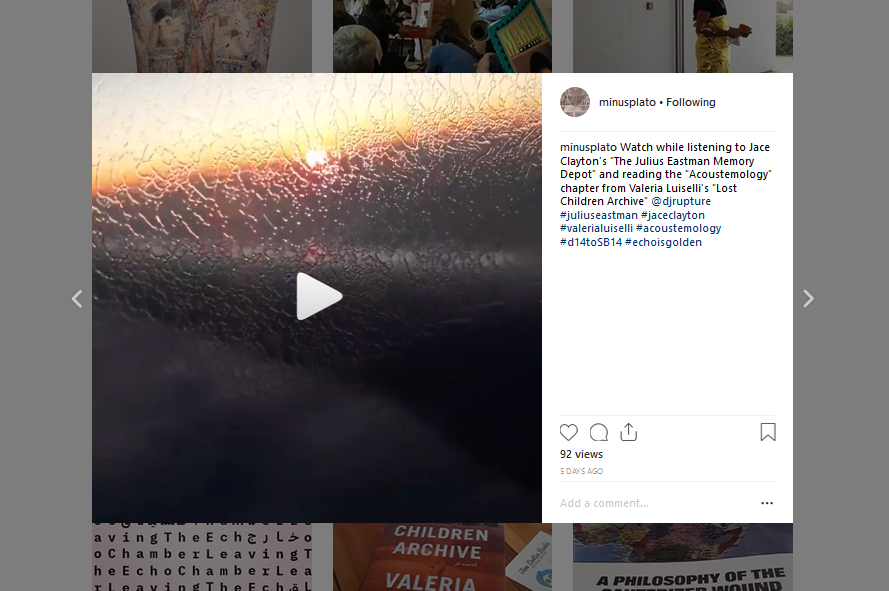
Or would these voices meld together into something approximating white noise? On board my flight, I took this video of the sunset through the de-icing liquid evaporating off of the plane’s window. While all you can hear is low roar of the engine and air-conditioning, as I noted on the post, I was listening to The Julius Eastman Memory Depot by sound artist, musician and DJ Jace Clayton (Tancons Look).
[Of course, in the present post, as these are screen grabs of the original Instagram posts, you cannot hear anything but silence (or at least the sounds surrounding you wherever this finds you). If your reading requires a soundtrack, here is an audio recording I made at SB14. It was recorded as I was watching Perfumed Nightmare (1977) by Kidlat Tahimik (Butt Journey) and traces 90 minutes of my nighttime wanderings through the works in Al Mureijah Square, including those by Otobong Nkanga and Emeka Ogboh (Kholeif Making), Akram Zaatari (Kholeif Making), Eisa Jocson (Tancons Look), Alaa Edris (Tancons Look), Christopher Cozier (Tancons Look), Aline Baiana (Tancons Look) and Wu Tsang (Tancons Look), before circling back to the end of Perfumed Nightmare and my walk back to my hotel.]
Now you have something to listen to, let me return to my story. After this first experience of Clayton’s work on my flight (and I am so grateful to him for introducing me to Julius Eastman’s work – which was, I just discovered performed at d14 – here’s the link), I would hear Clayton deliver a brief lecture that would re-figure white noise in terms of a more attentive listening and it made me wonder if this emphasis on listening is behind my gilded echo reference? (i.e. what makes an echo golden is that it is heard).
It is through listening that I am transported back to the Old Library of the Athens School of Fine Art (ASFA), where I put on the headphones hanging from the empty shelves (designed by Aristide Antonas) and heard sound snippets from the d14 public radio program Every Time A Ear di Soun. Included somewhere there was Transmissions by the Soundwalk Collective, comprising four of their audio works, such as Empty Quarter from the Rub’ Al Khali desert. Maybe it was this reference or the characters of soundscape-recorders in the book I was reading on the flight (Valeria Luiselli’s Lost Children Archive), but when I saw the film by Akram Zaatari (Kholeif Making) I was transfixed by a man with a microphone sheepishly approaching a herd of camels munching on some leaves, with the sound of their munching getting louder in the process.
Day 1 of SB14 (March 7, 2019)
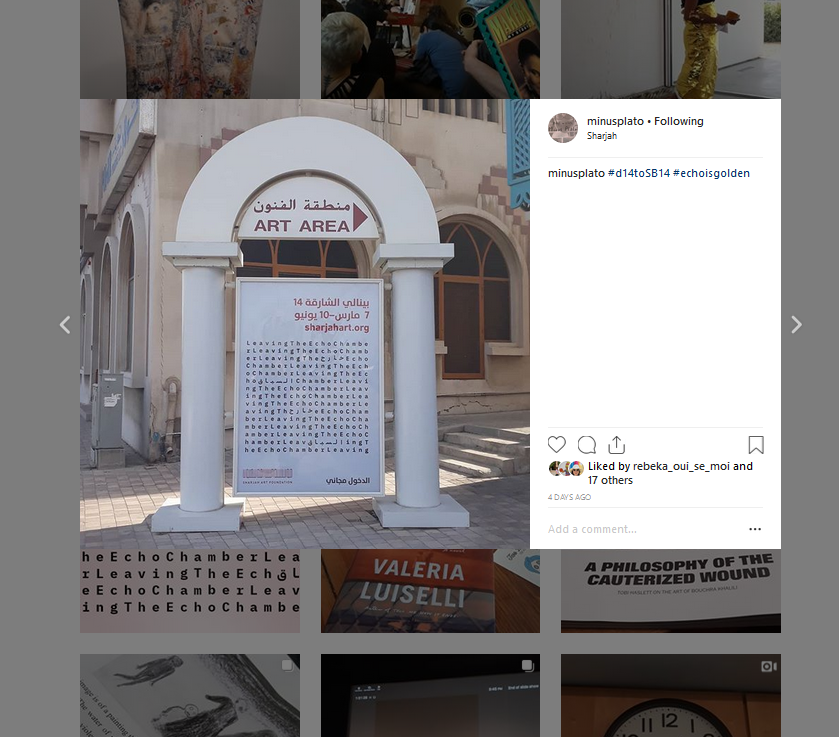
This was my first post on arriving in Sharjah. I took the photo because I found it somewhat amusing that there was a designated ‘art area’ in the city. (Little did I know that it was directing visitors to Arts Square, one of the main sites of the exhibition). It made me think about how in between editions of this global biennial there are local artists working away, hunched ready to spring into action when the international art world audience would role around again. Later I would think of these artists again when encountering Kamin Lerchaiprasert’s 31st Century Museum of Contemporary Spirit (Butt Journey) in the nearby Arts Square Collections building of a community of local and regional artists. Could this hum of creative action that goes on when the art world is not looking (beyond its echo chamber) be my golden echo? Think of all the artists whose work has been shown and supported by Rick Lowe‘s Victoria Square Project since d14 closed in Athens in Summer 2017.

While not an artwork, this video captured a moment after the official opening of the rolling up of the red carpet. It made me think of Roger Bernat‘s intervention at d14, wherein his fake stone is turned into a carpet as the ‘thing’ that controls collective action. For some reason, this non-art work brought to mind Christopher Cozier (Tancons Look), although I cannot exactly explain why. Perhaps it has something to do with the disturbance of power structures generated by the collective bodily movement of carnival in the streets? If so, then does this bring us back to the body of Echo before she became a voice (along with Danae, another ancient tale of female suffering at the hands of divine violence)? As Koyo Kuoh writes in her essay ‘The Whispering Gallery’, in the book published for Kholeif’s Making (which the curator generously gifted to me – I have yet to see the books for Butt and Tancons’ exhibition), this violence has both a past and present face:
“To imagine that the echo chamber is a symptom of the late-capitalist era is, however, a critical error. The ancient Greeks, well versed in barbarianism and tyranny through their own behaviour, warned us of the dangers of capitalism. The word ‘echo’ comes from the Greek ēchos, signifying sound – until a young mythological nymph named Echo gave it new currency.”
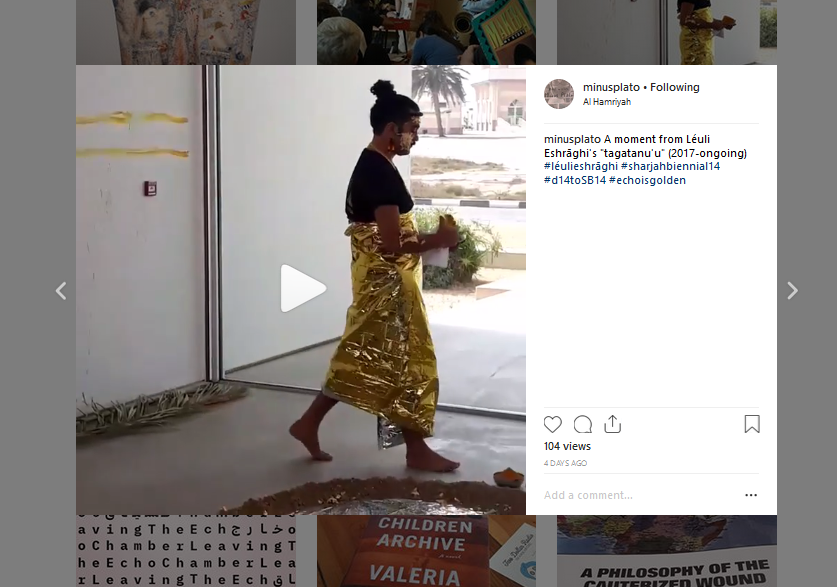
When I met Léuli Eshrāghi (Butt Journey) at Kalba during Land of Zanji (2019) the mesmerizing performance by Mohau Modisakeng (Tancons Look), as we paddled in the sea he told me that he wanted to ban cameras and phones from his performance the previous day in Al Hamriyah Studios. I proceeded to ask him if he would like me to delete my Instagram video, but he said no. I guess the damage had already been done. I had just been reading Candice Hopkins’ essay ‘The Gilded Gaze: Wealth and Economies on the Colonial Frontier’, from The documenta 14 Reader and I am sure there is a relationship between the act of recording and posting on social media performances of contemporary Indigenous artists and that of destructive gold prospecting by colonialist settlers. It is precisely why the video work of Isuma TV is so important both in producing Inuit-created videos and also hosting global Indigenous videos. Yet from my perspective and positionality, no matter how much I can distance myself from the colonial matrix of power, I am still benefiting from and working within it. As such, Echo is Golden will continue to be dazzled by the gold leaf and gold foil surfaces of Eshrāghi’s performance and try (in vain) to capture its deeper decolonial language in video form with all its ‘golden genealogies’ (and ‘golden showers’).
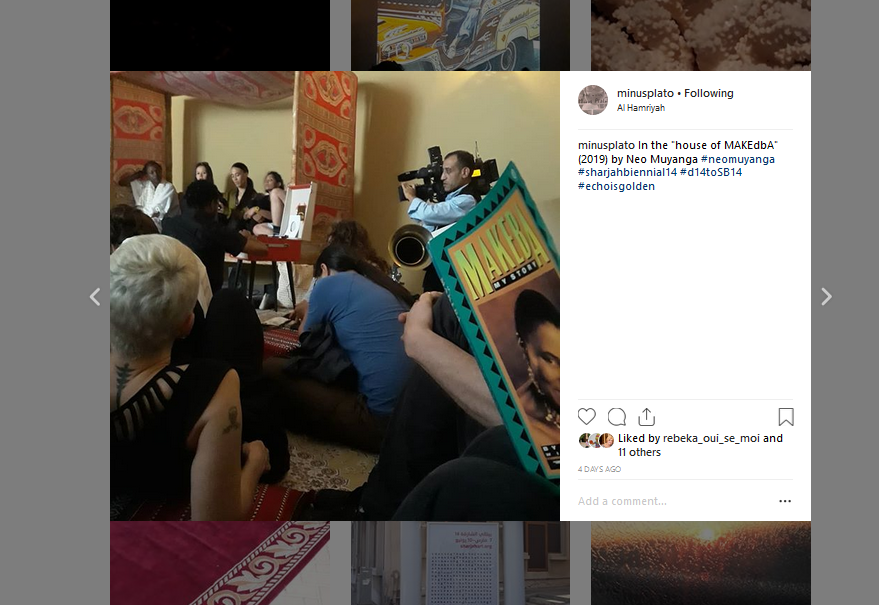
The cover song is a more literal form of the golden echo as homage. Neo Muyanga (Butt Journey) fuses his own compositions with a channeling of the voice and protest songs of his countrywoman Miriam Makeba. As the biography of Makeba was passed around the audience, I recalled the way the echoing act of homage and solidarity bridged artistic media in the sculptural forms of Nairy Baghramian at d14 and their ‘readings’ of short stories of Jane Bowles.
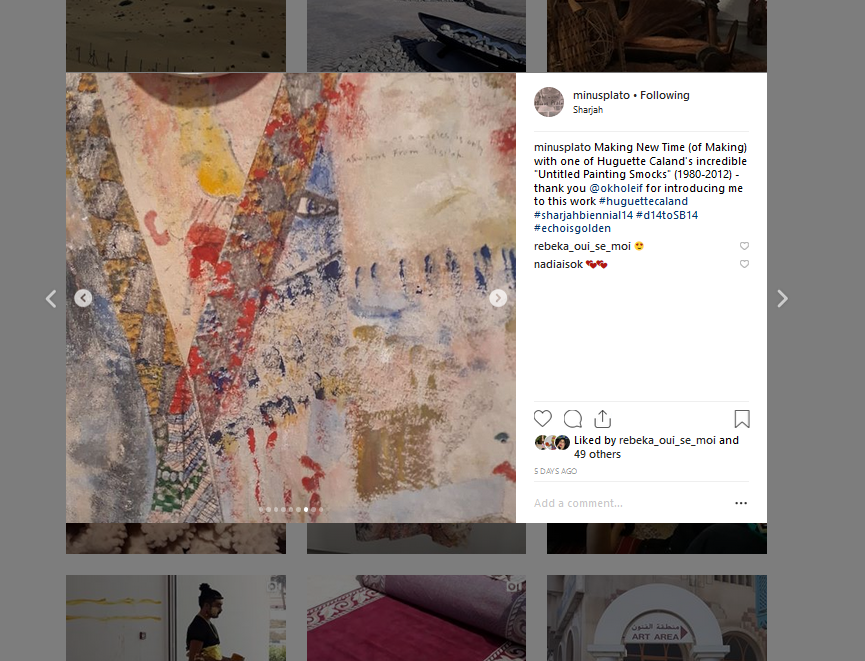
Yet, sometimes, the golden echo can be self-contained, not directing us elsewhere, but demanding we listen harder and look closer. The painting smocks of Huguette Caland (Kholeif Making) were a revelation and, like the d14 masks of Beau Dick, contained worlds.
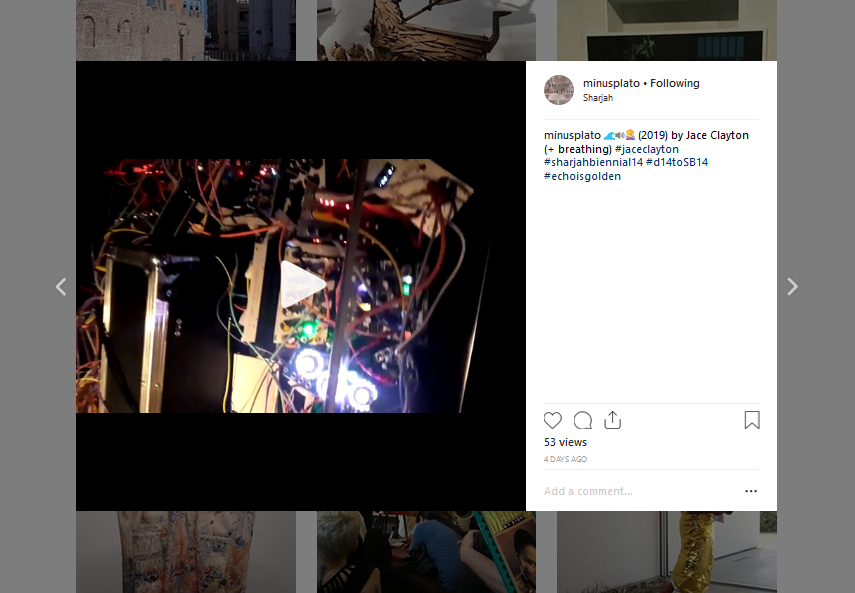
Even though I had posted about Jace Clayton (Tancons Look) earlier, I could not have anticipated the impact of his work in the Bait Obaid Al Shamsi building in Arts Square. Here was the lab of echo, where the artist peels away its golden skin and brings us face to face with its glistening guts. In a place where architectural beauty overwhelms (and we will return to the form of the courtyard later), this brutal unveiling of echo’s mechanics evoked our visit to the d14 studio apartment of Andreas Angelidakis in Athens.
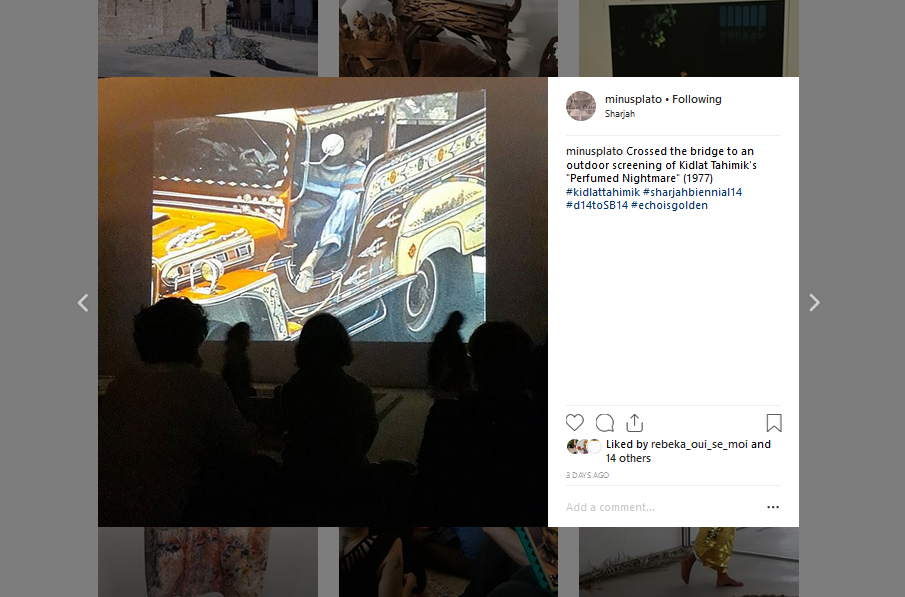
Of course, the echo is the double, the twin. But it also our past selves when they return to us. Introducing his 1977 film in 2019, Kidlat Tahimik (Butt Journey), asked us to see how those 40 years had treated him. Then suddenly, there he was echoing himself back at us from the screen of Mirage City Cinema, unchanged and lively in his polemic humor at the expense of the US and their long history of intervention in the Philippines. Such a confrontation with the echo of the self was made by the video of hands of Geta Brătescu at d14, now sadly unmoving, but remaining in the lines of her drawings.
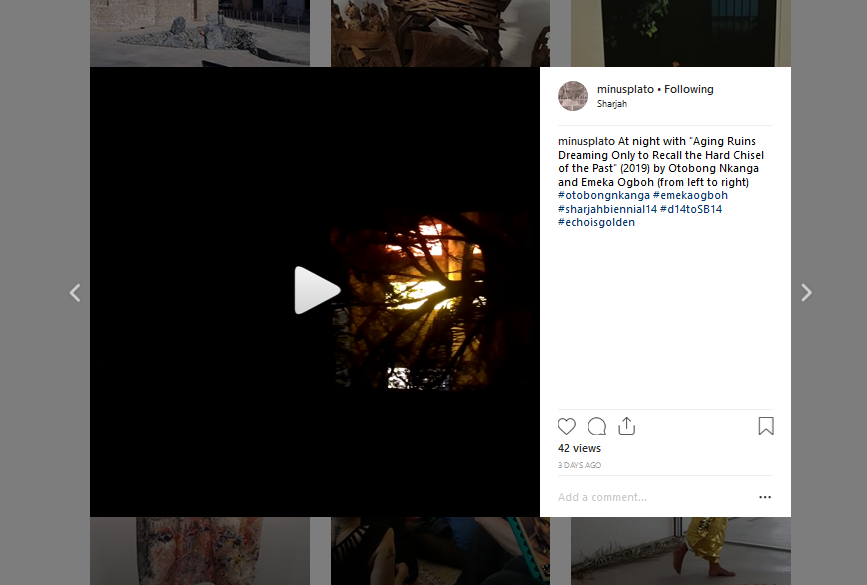
Ok, so as we have reached this point in my story (or, if you are listening, this moment in its soundscape), it will have become abundantly clear that I am toggling back and forth between SB14 and d14. My past four entries in particular have been especially blunt in moving from one to the other. But now things get interesting. Remember hearing the hand-claps, gurgling water and eerie voices early in your sonic journey? Well, that was from the work by Otobong Nkanga and Emeka Ogboh (Kholeif Making). Both artists participated in d14 and so their (award-winning) contribution to Leaving the Echo Chamber was always going to be of vital significance for my project. Of course, I cannot do justice to it here (nor to its echoes of their individual works between Athens and Kassel), so let me limit myself to a few words about its title: Aging Ruins Dreaming Only to Recall the Hard Chisel of the Past. These words evoke the stone body and projected voice of the caryatid, but transformed into a dream where they are carved to flow, and their sufferhead song of the way earthly things are going.
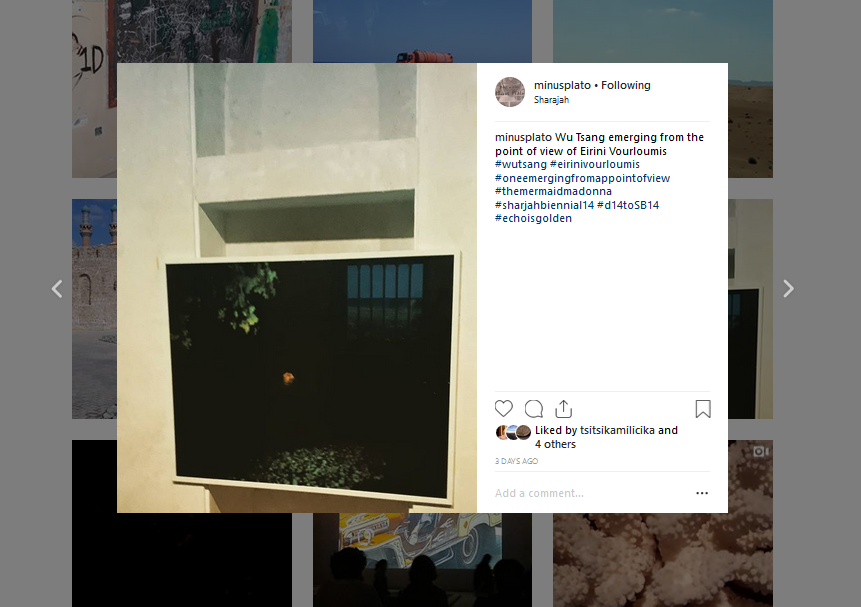
If I was reticent about writing here about the direct echoes of works between artists that were part of both SB14 and d14, I feel even more so when confronted by works that radically transformed by experience of both exhibitions and my entire project. The film and installation One emerging from a point of view (2019) by Wu Tsang (Tancons Look) is one such work. It was arresting, grabbing me by the neck and shoulders in a way that only only remember one other moving image art work doing in my life (Bouchra Khalili‘s The Tempest Society) and saying: ‘this is it, this is what you have been searching for. This is your Ithaca.’
Day 2 of SB14 (March 8, 2019)
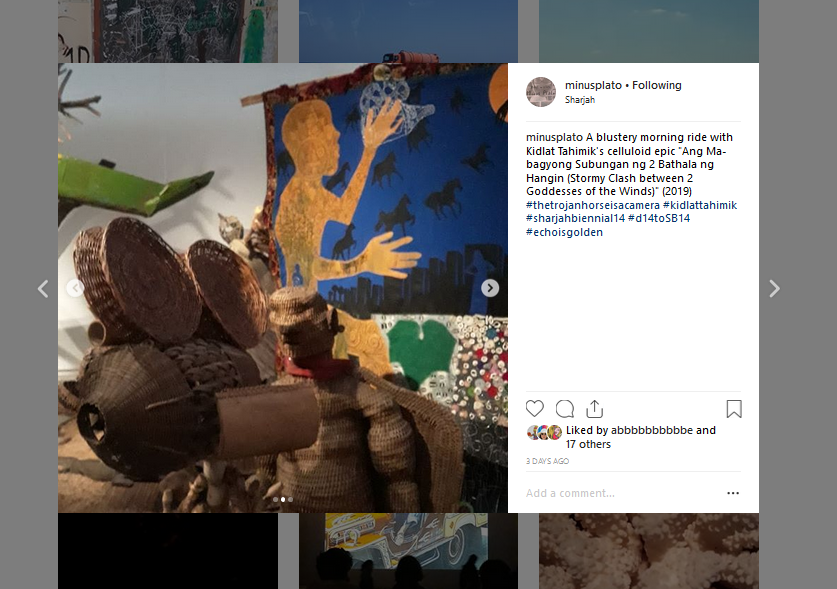
Maybe I felt guilty that I had left Perfumed Nightmare to wander through other works, and that is why I started my second day at SB14 with Kidlat Tahimik (Butt Journey) and his epic of the winds. Or perhaps it was a Siren call that drew me in, somewhere between his Marylin Monroe and the seductive exacting realism of Irena Haiduk. Either way, this morning proved that Echo was not standing alone, decked out in her golden dress, there were other bodies and voices to accompany her.
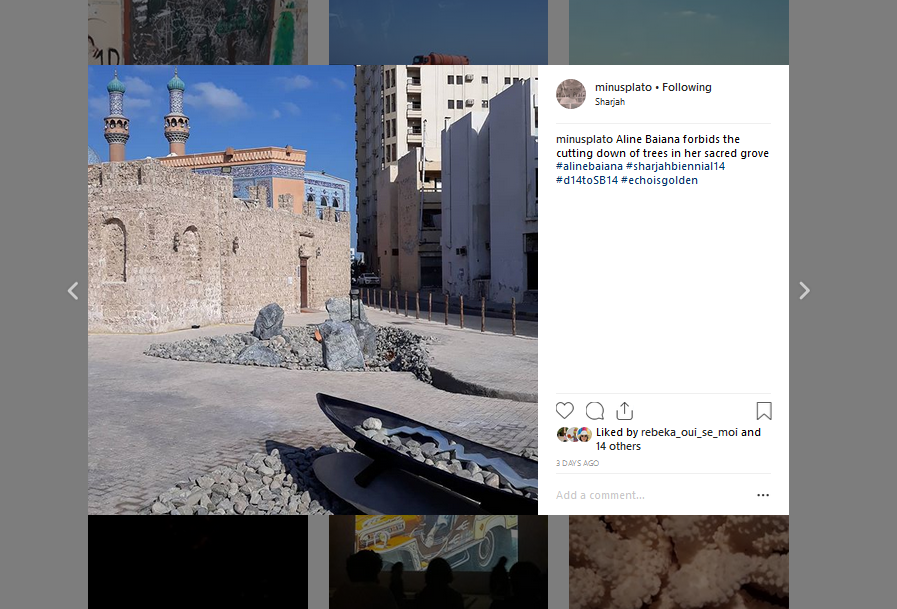
Mestra, for example. The shape-shifting daughter of the impious Erysichthon, who cut down the sacred trees in Demeter’s grove. She was there in the work of Aline Baiana (Tancons Look). Between the Amazon and Lebanon, the artist was whispering into a hole to tell truth to tyranny, with the Adonis myth as an ally. But Mestra can help too, by transforming herself and placing herself into different contexts to tell the same age-old story of imperial patriarchal violence against the land and its Indigenous populations. At d14, she was there in the guise of Regina José Galindo.

Leaving Sharjah for Kalba and a day of performances (all for Tancons Look – hence the comment and hashtags!), this Baudrillardian echo came from another: Ian Cheng (Kholeif Making) and his live simulations. Furthermore, it dawned on me (on this ride) how little d14 work was simulated by the digital real, the closest being the electroacoustic audio and video installations of Terre Thaemlitz.
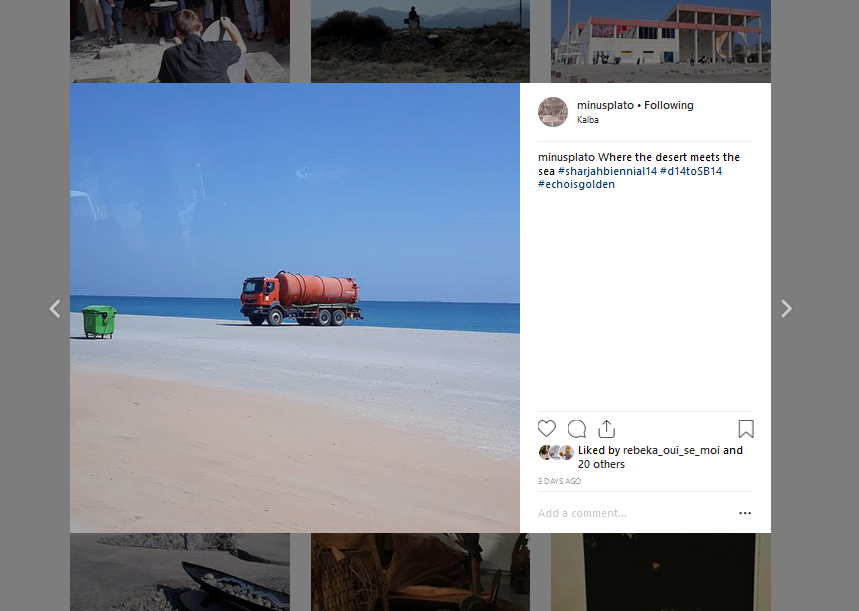
Here is me playing Luigi Ghirri (who was at neither SB14 nor d14), while back in the Ceramic House of Calligraphy Square, Adriana Bustos (Butt Journey) was orchestrating a more subtle composition of the interplay of color and absence. If only her compatriot David Lamelas had been live streaming it!
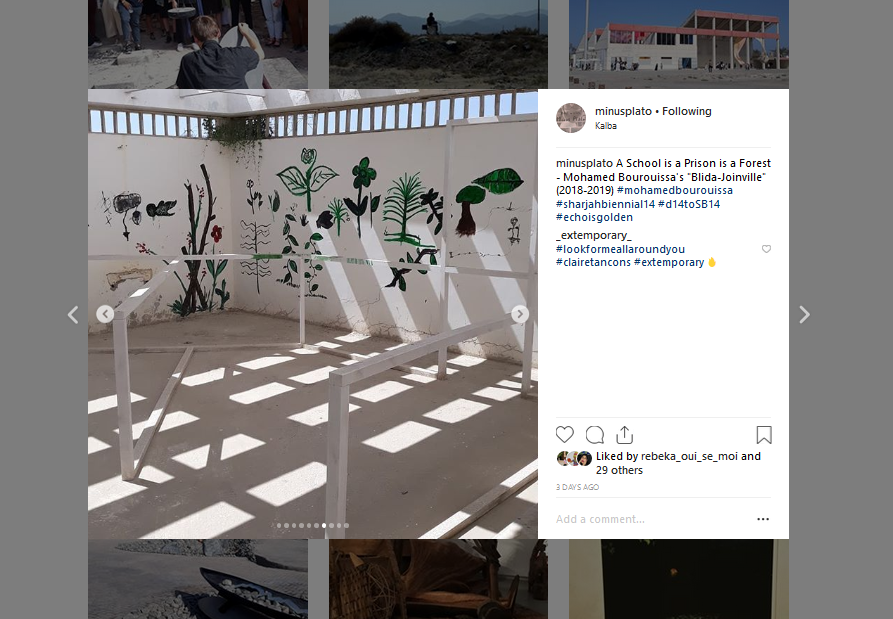
Our first stop in Kalba (which may have been planned to be our last stop if things had been different) was the overlapping layers within the society of control in the work of Mohamed Bourouissa (Tancons Look). For many of my fellow visitors, the school, the hospital and the prison, and all of the heterotopias of surveillance, were screaming: beautiful world, where are you? I was transfixed on the naming of trees (thanks to Abel Rodríguez).
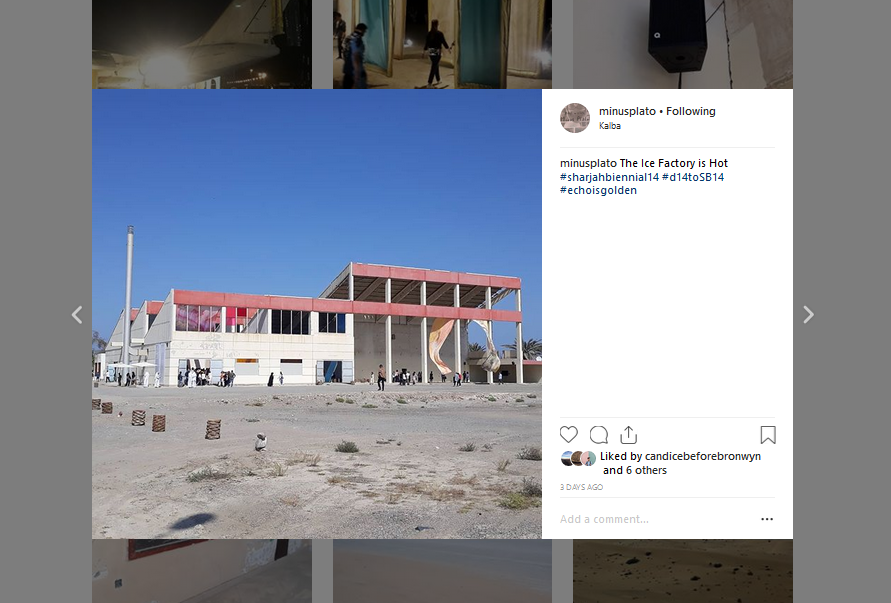
The Kalba Ice Factory no longer produces ice. Why do we cling to the name of a thing when it has ceased to be that thing? The name is an echo without a point of origin or once that origin has been destroyed (cf. Banu Cennetoğlu). Candice Breitz (Kholeif Making) knows what I’m talking about. Listen to her tell it as it is:
“This incomplete survey of the analogue intestines of home video is not titled Merda d’artista or Boîte-en-valise. Despite its investment in strategies of Reversal and Retrospection, this mute depository comes both too early and too late to serve as a convincing Pense-Bête. These are neither the tales of Scheherazade nor the boxes of Pandora. These miniscule coffins are not Date Paintings or Time Capsules, nor are they adequate Surrogates for the moving images that they obscure. This Verb List is not a definitive Atlas. Nor is it an encyclopedia or compendium or index or library or collection or dictionary or inventory or archive or catalogue. Digest could not accurately be described as a monograph or a biopic or a catalogue raisonné. This is not art about art or about artists or about the art market. This is not a love song or a selfie.”
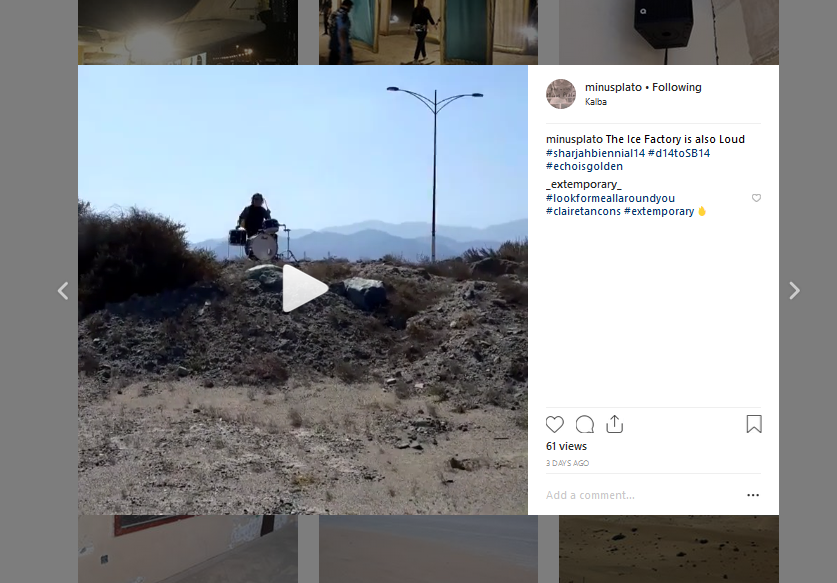
Does the expectation of an echo (in its regular or golden form) provoke the making of a sound in the first place? For a mere audience member, such an expectation made me return at night to the prism of silent speakers and blank screens by Tuấn Andrew Nguyễn (Butt Journey), hoping for something to sound and show. (Pope. L made me do this again and again in Athens and Kassel, waiting for the whisper). Here it happened with a bang, as I ran back to the silent drummers of Isabel Lewis, Matthew Lutz-Kinoy,HACKLANDER / HATAM (Tancons Look), itching for them to kick into action.
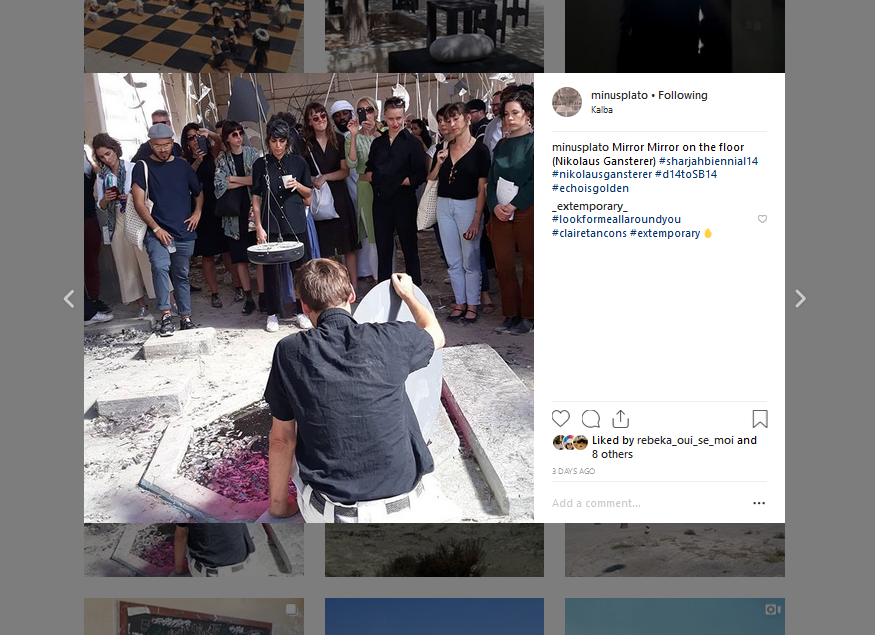
While thinking about the audience, let’s return to Koyo Kouoh’s ‘The Whispering Gallery’ in the book for Kholeif Making:
Cursed by Zeus’ wife and destined merely to repeat the words of others, Echo also had the bad luck of falling in love with Narcissus. In all variants of the myth, Narcissus is finally destroyed by his enthrallment with his own image and inflated sense of self-importance. He is spurred on and aided by Echo, who perpetuates the hunter’s self-aggrandising discourse through her constant repetition of his words. In the intervening years, somewhere between the moment Narcissus transformed into a daffodil and Donald Trump was elected the 45th President of the United States of America, an individual’s capacity to strike out against hegemonic information streams – directed by religious doctrine, monarch or state, or, in many cases, a potent combination of all three – has been largely overestimated.’
Hear hear! We, both as audience members and voters, are too much enthralled. Just look at us watching Nikolaus Gansterer (Tancons Look)! But
what would it mean to step outside of this carefully structured system? Hiwa K knows, as does anyone who has seen the bodies at work in T. Shanaathanan (Butt Journey) at the Sharjah Center for thee Art of Arabic Calligraphy and Ornamentation.
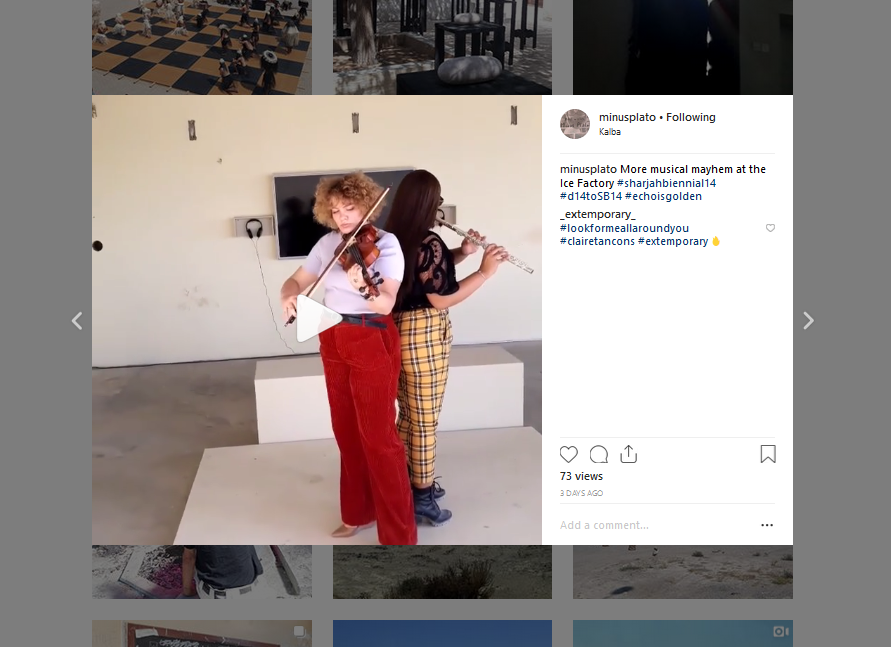
Back to the spectacle. Echo and Narcissus were the original duet. There were lots of dueling banjos in the work of Isabel Lewis, Matthew Lutz-Kinoy, HACKLANDER / HATAM (Tancons Look) – flute/violin, drums/bongos, cars/bodies. But as we move from space to space, sound to sound, there is that nagging thought: maybe it is all in our head(s)? What do you think, Jon Rafman (Kholeif Making)? Try telling thatto Rebecca Belmore.
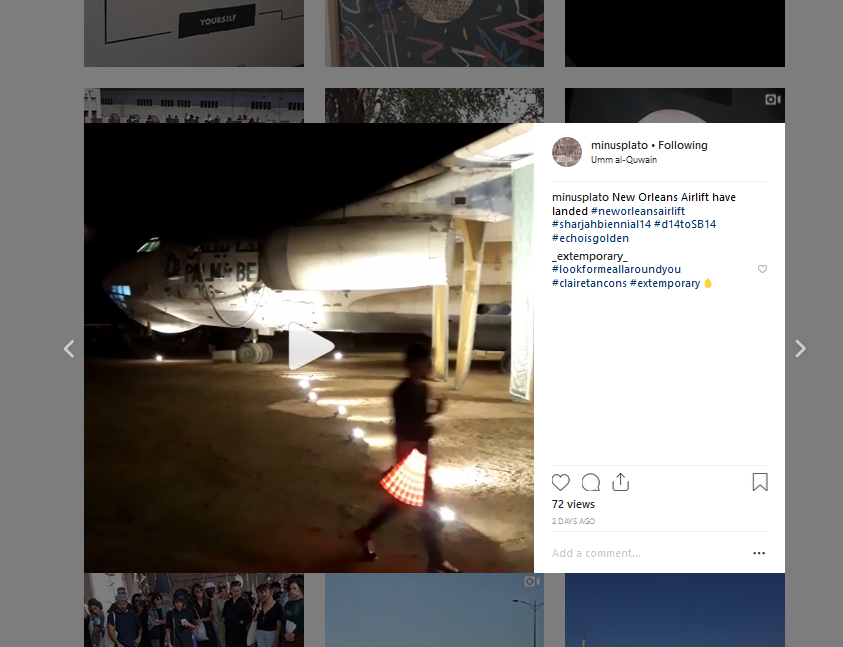
And after a long day and a longer ride, bringing out the top guns, drum-roll please, the finale New Orleans Airlift (Tancons Look). The spectacle takes the wheel, as the jumbo jet equivalent of a Parthenon of Books (Marta Minujín), transporting us back to another model of epic transportation from another age of so-called discovery – Ahmad Fuad Osman (Butt Journey).
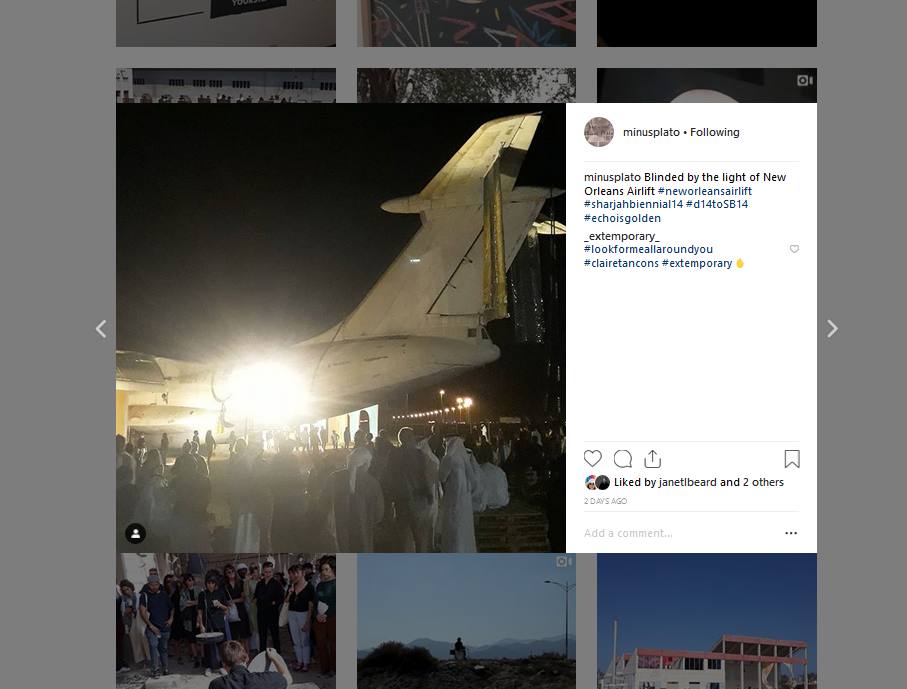
But who is behind the wheel, in the cockpit of capital? And can you say no, I will not fly on your crashing Boeing 737 Max aircraft. Give me my money back! Even if you prefer to walk to see the blue sheep of Aboubakar Fofana, know that New Orleans Airlift (Tancons Look) offer the alternative, even as if they look like being part of the problem. Ride with them!
Day 3 of SB14 (March 9, 2019)
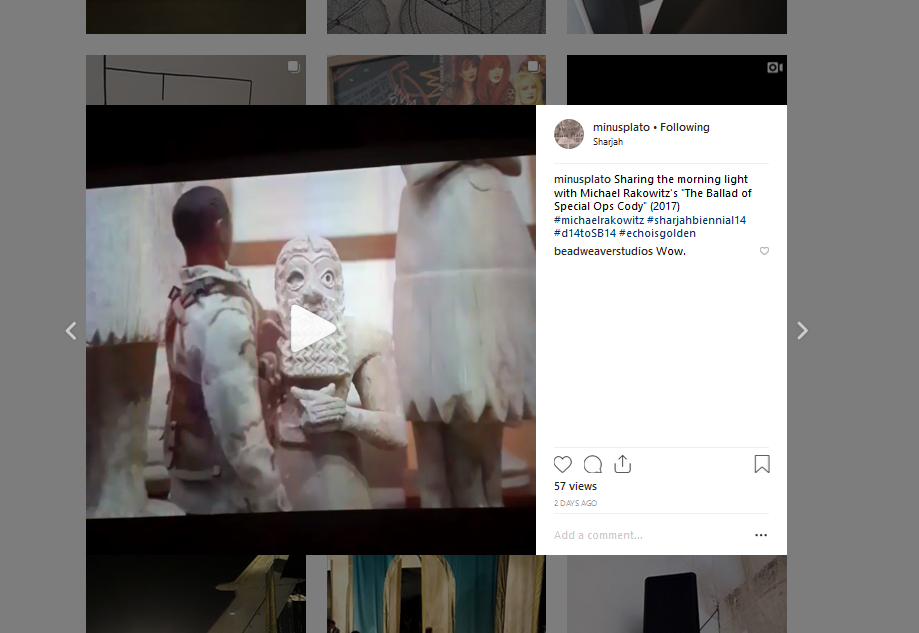
Our last day began back in the white cube with a miniature epic by Michael Rakowitz (Kholeif Making), an artist who know something about the social practice airlift (cf. his A Color Removed at SPACES in the inaugural FRONT Cleveland Triennial). His museological war ballad ignites an insistent question, echoing throughout the day, and culminating in the presentations on the panel organized by Tancons Look – To Pay and Repair? The name of this song is debt and restitution, performed by Maria Eichhorn.

Or the screaming and laughter of the Benin Bronzes, performed by Leo Asemota (Tancons Look) and remixed by Leo Asemota.
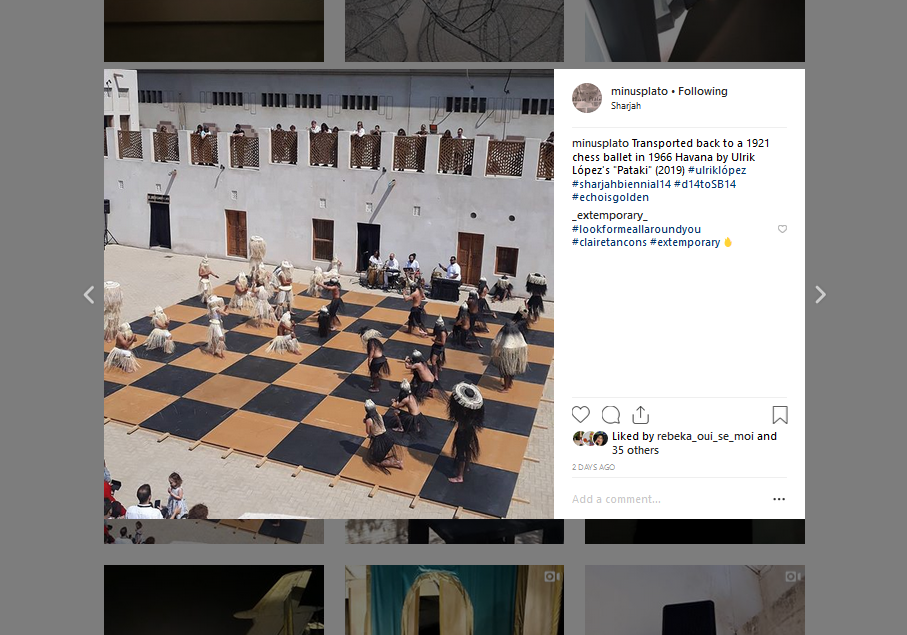
Or the Cuban ballet from out of the mainframe of chess-playing Modernism, choreographed by Ulrik López (Tancons Look), Cameroon-remake by Bili Bidjocka.
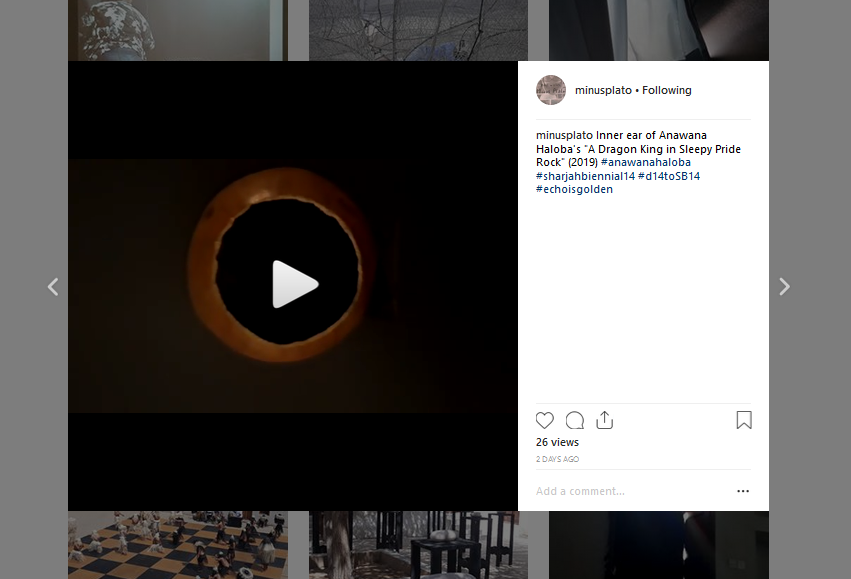
Or the guira shell soundscape from and across the USA, Germany, Greece, Cuba, Norway, China and Zambia, conducted by Anawana Haloba (Butt Journey), accompanied by María Magdalena Campos-Pons and Neil Leonard
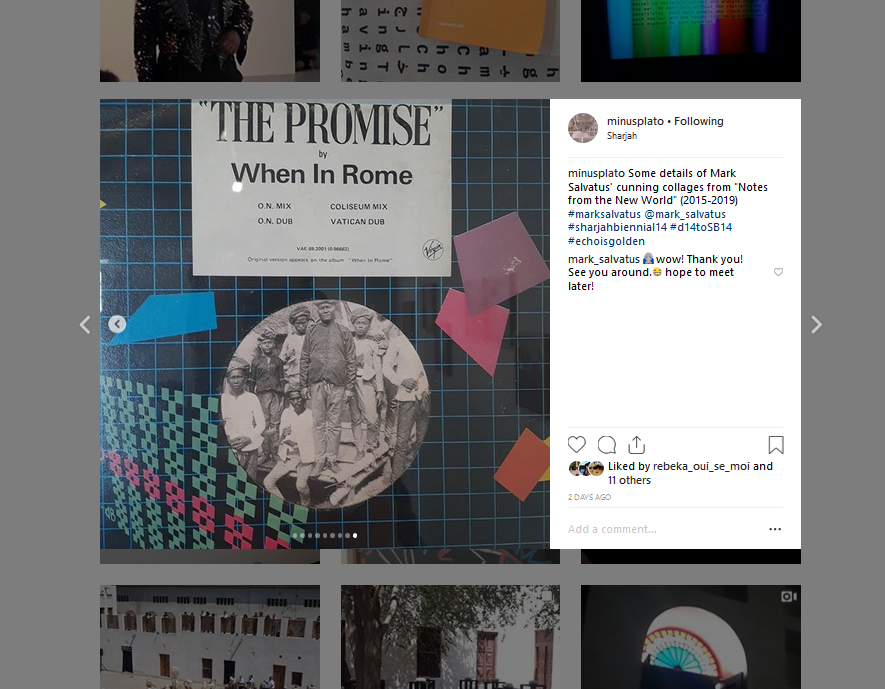
Or the pop cultural reference of immigrant labor, recorded by Mark Salvatus (Butt Journey) and performed by Negros Tou Moria.
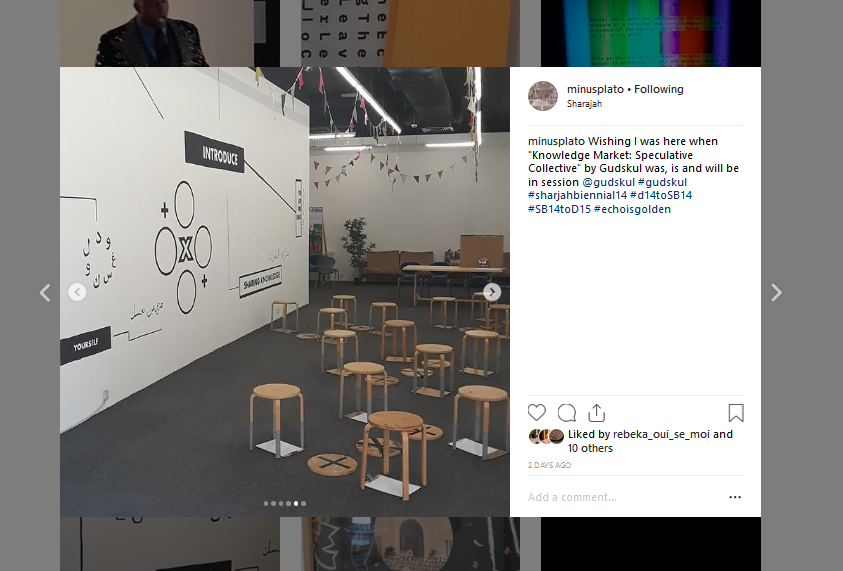
Seeping out of this particular echo chamber, one that confronts colonial violence with inventive resistance, is a whisper of hope for the future, our future. Transmitted by RURU Radio of d14 in 2017 and taught at GUDSKUL (Butt Journey) at SB14 in 2019 will be the promise of ruangrupa‘s D15 in 2022.
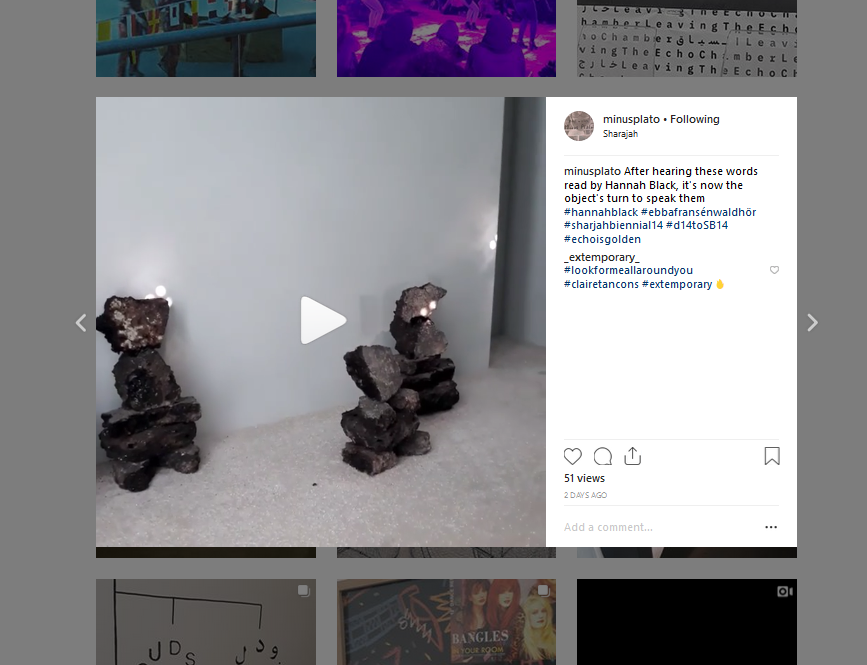
But for now, let’s stick to the echo before us. How does presence (being there) gild the echo? Only those of you who were present at around 2pm in the courtyard of Bait Obaid Al Shamsi could have heard the speaking rocks of Hannah Black and Ebba Fransén Waldhör (Tancons Look) immediately after their recital by the embodied voice of their author. (I wish I could have been in on the Athens coastline on April 10th, 2017 when Cecilia Vicuña performed her own words).
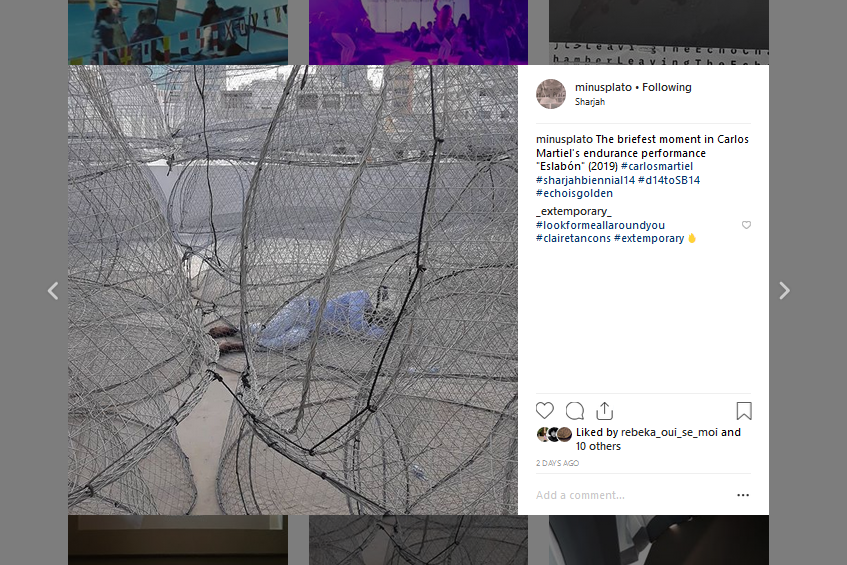
How long do you have to be there for you to have really been there? Ask Carlos Martiel (Tancons Look) if he saw you leave after taking a photo. Or Prinz Gholam, while in mid-pose.
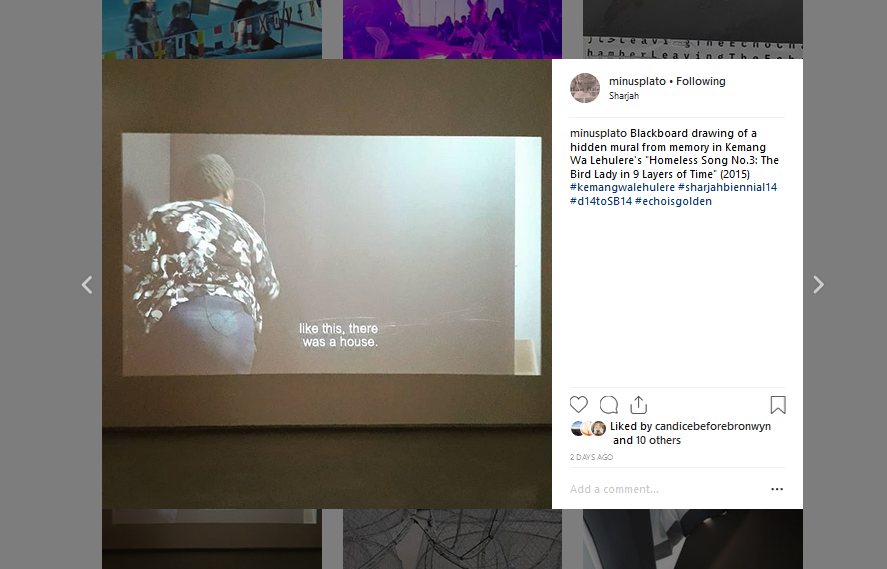
Yet it is artists who can recreate experiences for us, and their echo is enough without us having to be present at the event. Kemang Wa Lehulere (Kholeif Making) locates that echo in the film between a memory and a blackboard. Michel Auder‘s videos are all echo in this form.
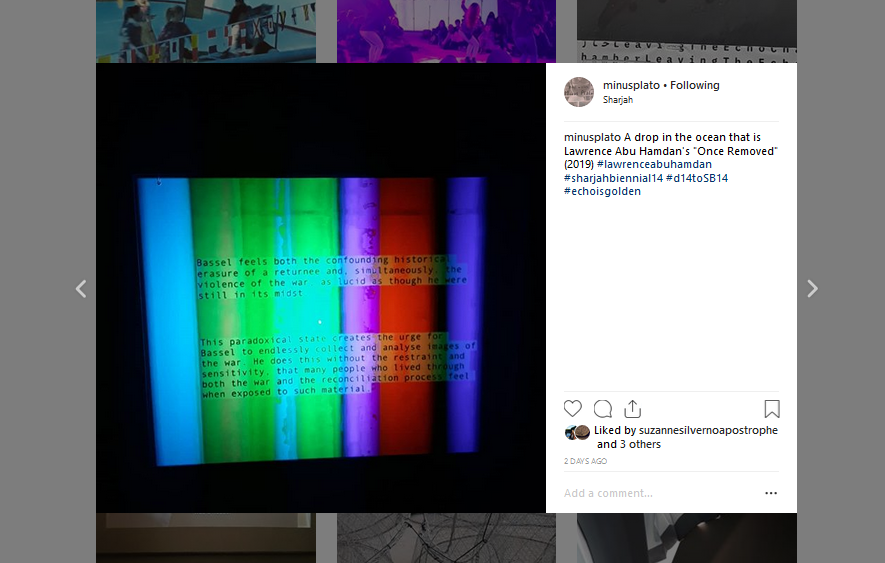
Lawrence Abu Hamdan (Kholeif Making) echoes Lawrence Abu Hamdan
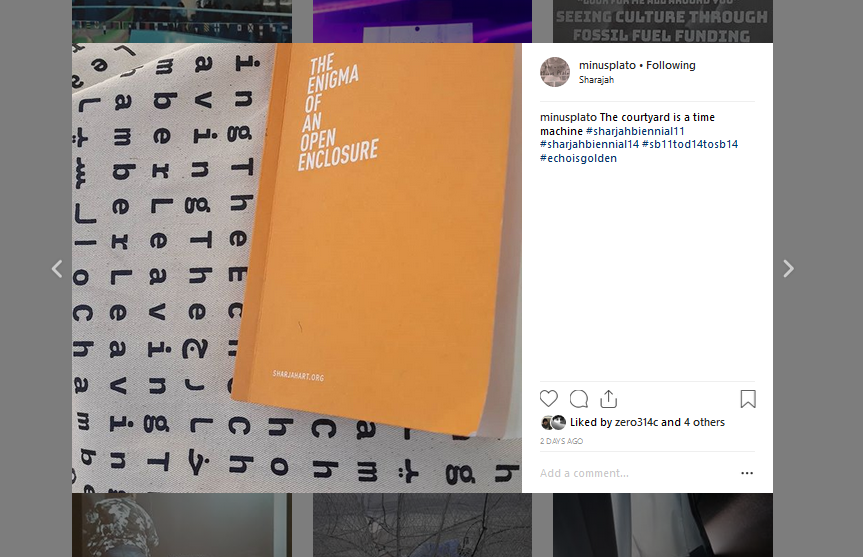
So, if some artists make you need to be there and others don’t, what about the institution? Of course, they want you to get on that plane and return two years later. They want to you to see how the only authentic experience is to locate yourself in the courtyards of Sharjah, the original echo chamber escape route, that enigma of the open enclosure. It is here that I need to whisper (as if into a hole) another impetus for my visit to SB14. It was not all about d14 and its resonances, but also about how SB11 paved the way for d14. How did Yuko Hasegawa’s biennial (and her emphasis on the courtyard) of delinking dewesternizing decolonialism (pace Walter Mignolo) back in 2013 inform Adam Szymczyk? I need to talk to someone who was there, like Nevin Aladağ.
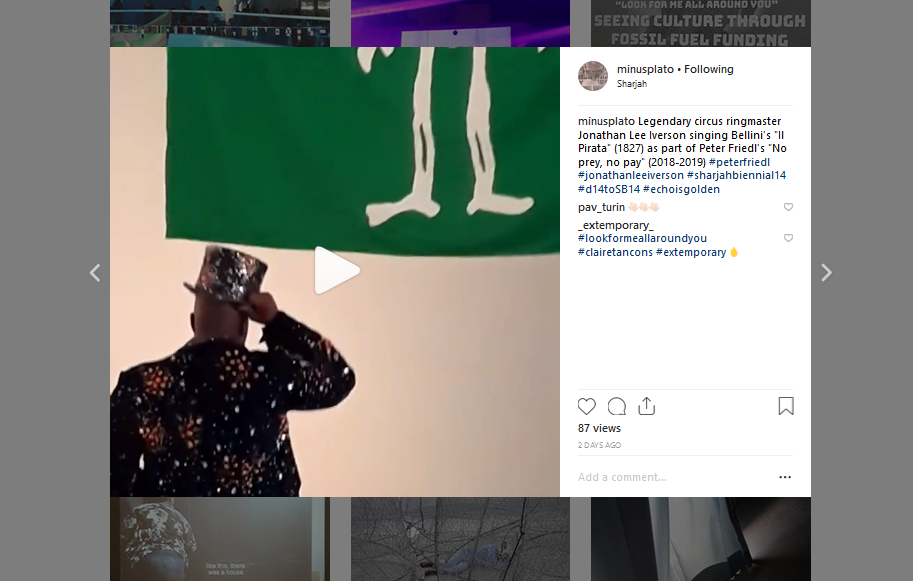
Since I am already whispering here, I have to admit that even though I came to see Peter Friedl (Tancons Look) and hisNo Prey, no Pay (2018-2019), I only watched a few minutes of Peter Friedl‘s Report (2016) in Athens. What is your biggest biennial regret?
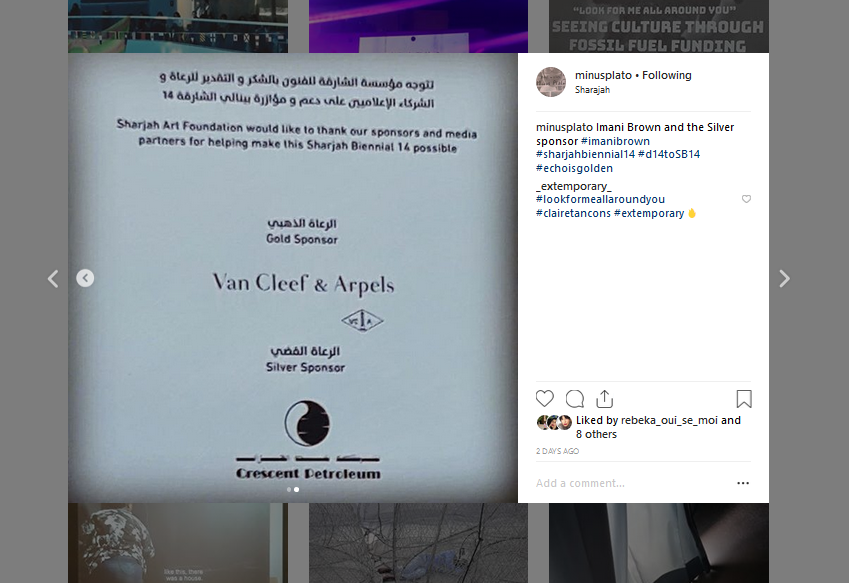
Speaking of regrets, what about having Crescent Petroleum as a sponsor and also including talk about oil and corporate biennial/exhibition sponsorship? (Remember d14 is owned by nobody in particular, at least now, if not then).
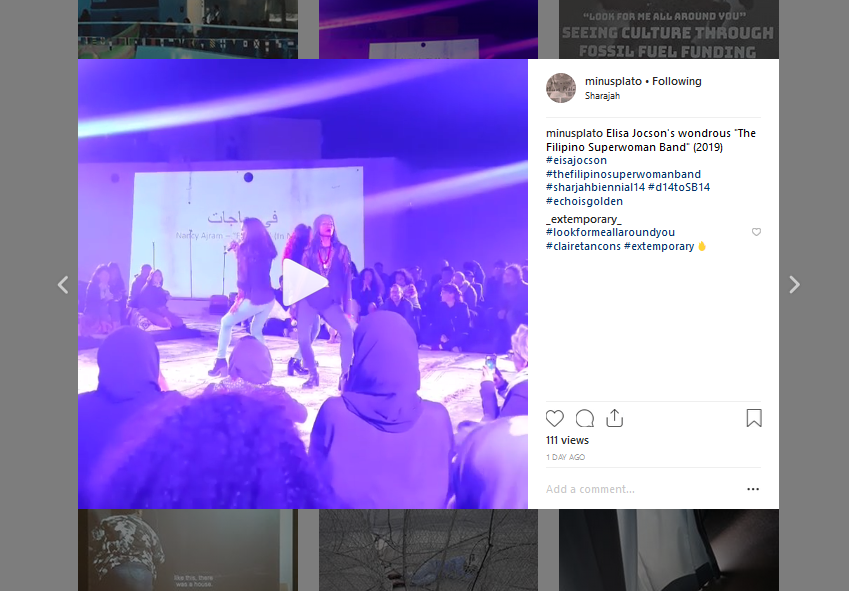
But let’s not end this on a downer. Lets not let our soundtrack be one of loss and destruction (with the late, great Susan Hiller), but a joyously critical karaoke with Eisa Jocson (Tancons Look).

SB14 was so fresh and refreshing. Just look at Tracey Rose (Tancons Look). From the Tracey Rose of d14, I was expecting decolonial alarm sounding and rough riding racists (from her red caryatid to her WhoreMoans videos), but instead it was all smooth white Russian skating and Kate Bush crooning. No other work at SB14 made me doubt my own echo chamber more than this slippery spectacle. That said, what did you expect, you ass-eared Midas?
Return from SB14 (March 10-12, 2019)
When I left the ice-rink, Sharjah, the airport and returned home, I didn’t know how to keep my experience from fading into the air of routine, teaching and everyday life. I definitely didn’t plan on spending two full days writing this post. I blame reading the text ‘The Unknowing X’ by Sophia Al-Maria in the book by Kholeif Making. I don’t want to spoil it by rehashing it here, but if you can imagine reading James Baldwin and being given a card from the Kuan Yin Oracle set of a goddess Who Perceives the Sounds of the World, you’d be close. Instead, I just want to leave you with her closing words, mixed with those of Pauline Oliveros that close The documenta 14 Reader and leave them here, in this room, to resonate as a placeholder for that ever elusive golden echo:
Listening to this space I sound this space.
Use the tools you are given.
Listening to the energy of all who are present I sound this energy.
Confront your histories with honesty.
Listening to my listening and your listening I make this music here and now with the assistance of all that there is.
Rescue the unknowable future.
I dedicate this music to a world without war.
This post is too long – while I appreciate all the work that went into writing it; wouldn’t it have been better to publish it in two or three parts?
Thanks for the feedback – I agree its too long, but I wanted to echo the reading experience with an hour and a half visit through the Sharjah Bienial 14 (see the audio file). So if you have time to spare, sit back & enjoy the ride!